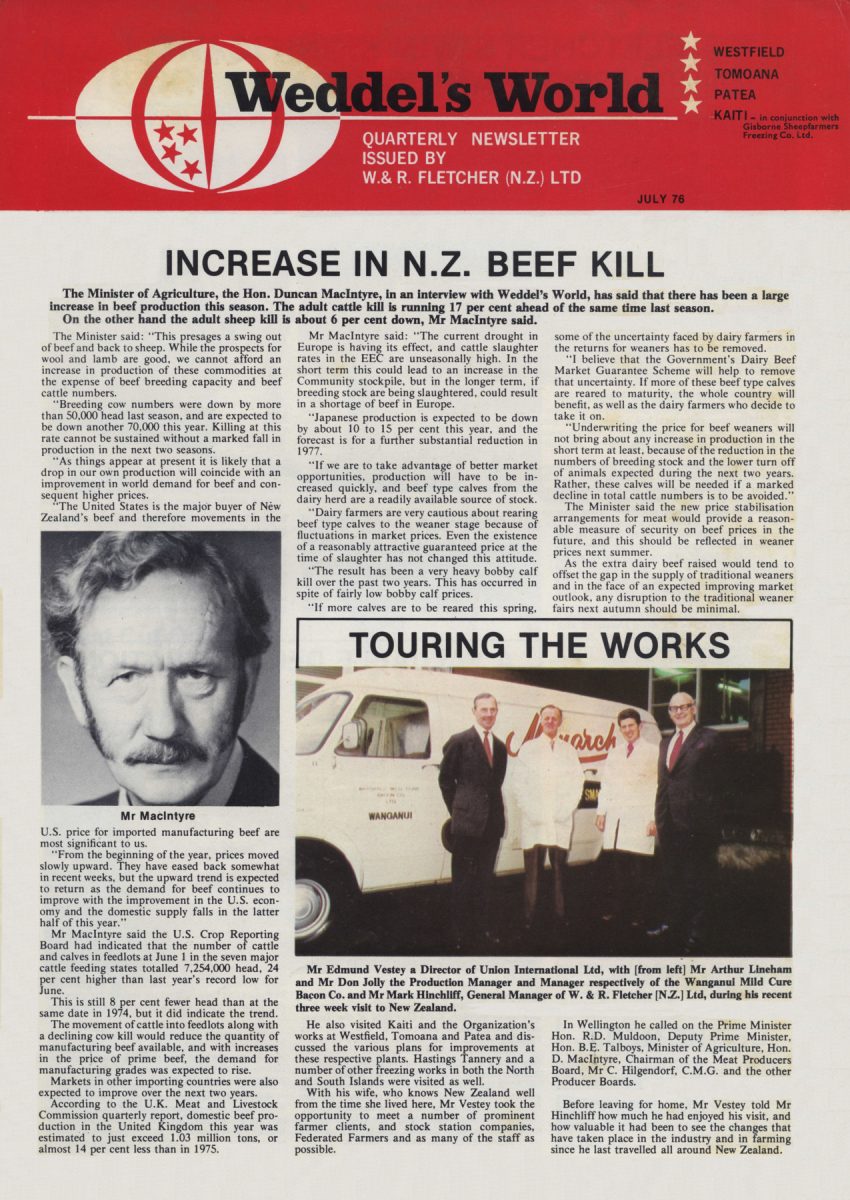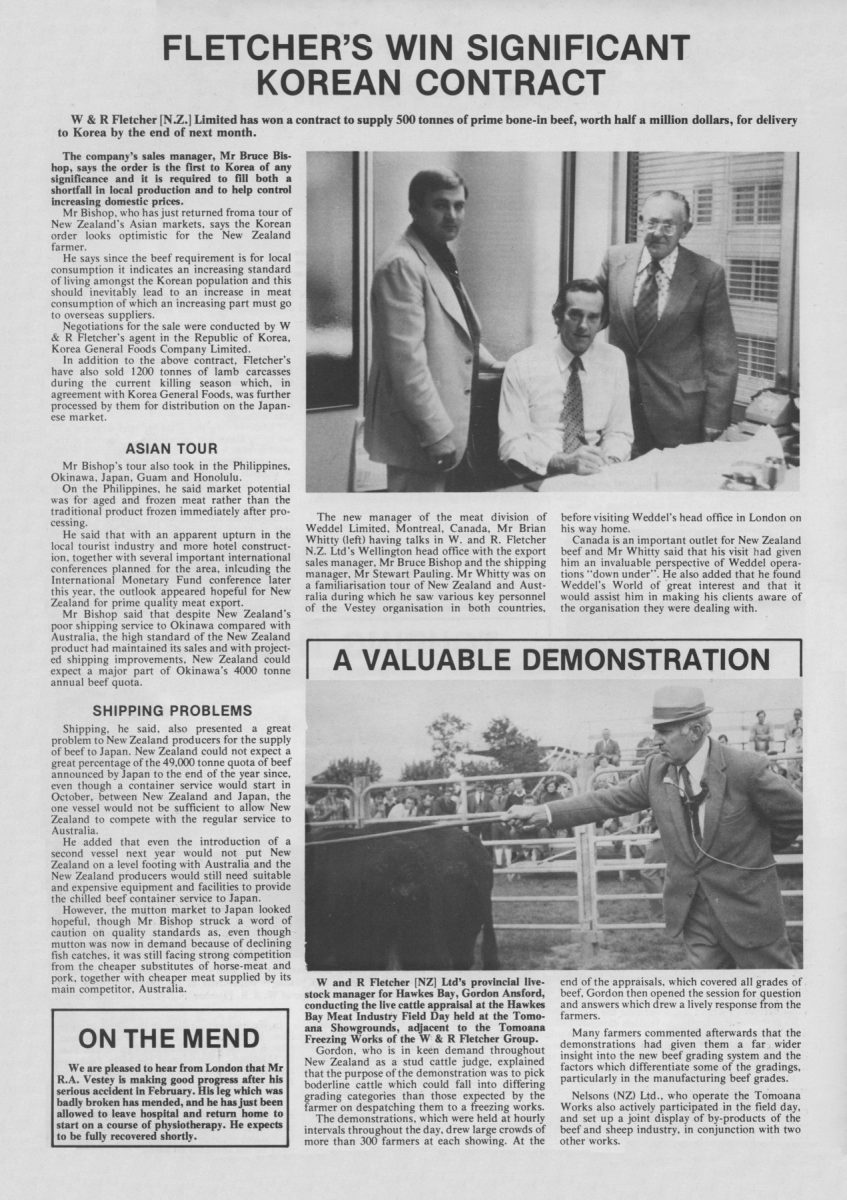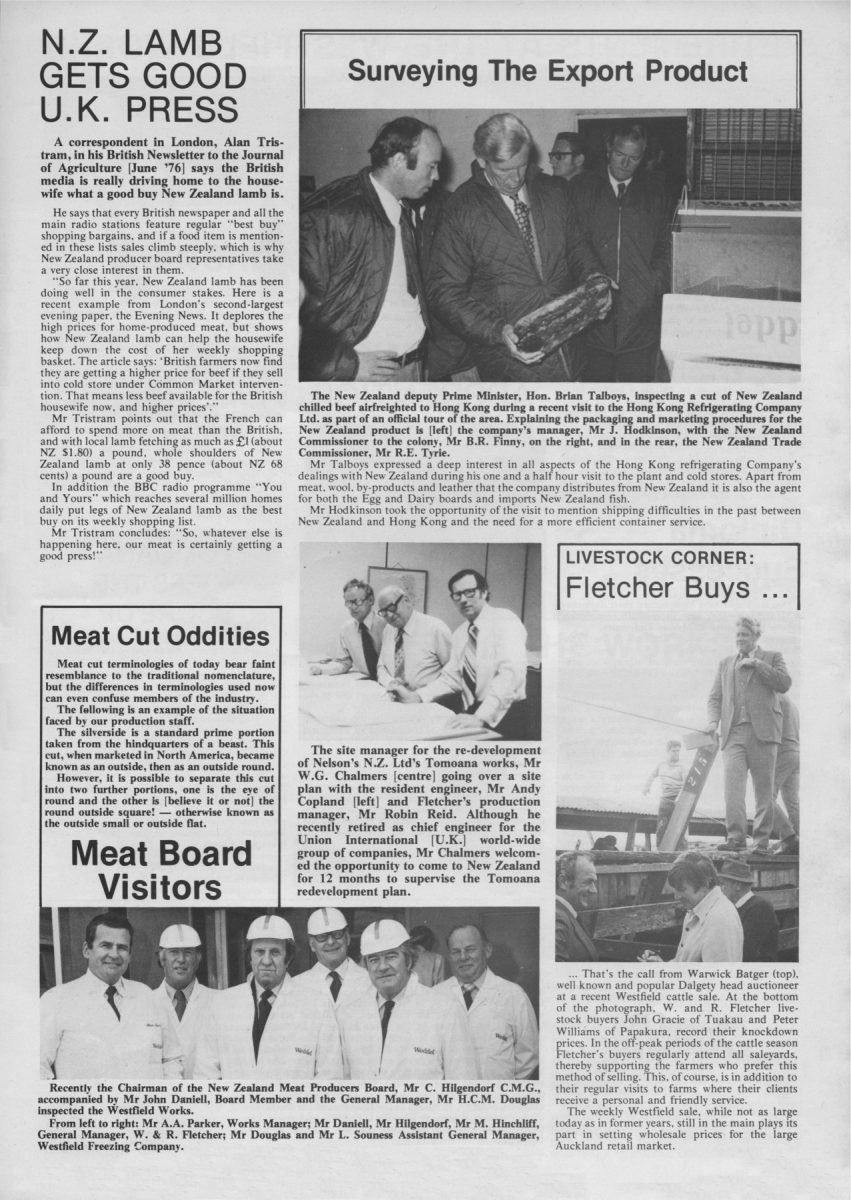Weddel’s World
WESTFIELD
TOMOANA
PATEA
KAITI – in conjunction with Gisborne Sheepfarmers Freezing Co. Ltd.
QUARTERLY NEWSLETTER
ISSUED BY W. & R. FLETCHER (N.Z.) LTD
JULY 76′
INCREASE IN N.Z. BEEF KILL
The Minister of Agriculture, the Hon. Duncan MacIntyre, in an interview with Weddel’s World, has said that there has been a large increase in beef production this season. The adult cattle kill is running 17 per cent ahead of the same time last season. On the other hand the adult sheep kill is about 6 per cent down, Mr MacIntyre said.
The Minister said: “This presages a swing out of beef and back to sheep. While the prospects for wool and lamb are good, we cannot afford an increase in production of these commodities at the expense of beef breeding capacity and beef cattle numbers.
“Breeding cow numbers were down by more than 50,000 head last season, and are expected to be down another 70,000 this year. Killing at this rate cannot be sustained without a marked fall in production in the next two seasons.
“As things appear at present it is likely that a drop in our own production will coincide with an improvement in world demand for beef and consequent higher prices.
“The United States is the major buyer of New Zealand’s beef and therefore movements in the U.S. price for imported manufacturing beef are most significant to us.
“From the beginning of the year, prices moved slowly upward. They have eased back somewhat in recent weeks, but the upward trend is expected to return as the demand for beef continues to improve with the improvement in the U.S. economy and the domestic supply falls in the latter half of this year.”
Mr MacIntyre said the U.S. Crop Reporting Board had indicated that the number of cattle and calves in feedlots at June 1 in the seven major cattle feeding states totalled 7,254,000 head, 24 per cent higher than last year’s record low for June.
This is still 8 per cent fewer head than at the same date in 1974, but it did indicate the trend.
The movement of cattle into feedlots along with a declining cow kill would reduce the quantity of manufacturing beef available, and with increases in the price of prime beef, the demand for manufacturing grades was expected to rise.
Markets in other importing countries were also expected to improve over the next two years.
According to the UK. Meat and Livestock Commission quarterly report, domestic beef production in the United Kingdom this year was estimated to just exceed 1.03 million tons, or almost 14 per cent less than in 1975.
Mr MacIntyre said: “The current drought in Europe is having its effect, and cattle slaughter rates in the EEC are unseasonally high. In the short term this could lead to an increase in the Community stockpile, but in the longer term, if breeding stock are being slaughtered, could result in a shortage of beef in Europe.
“Japanese production is expected to be down by about 10 to 15 per cent this year, and the forecast is for a further substantial reduction in 1977.
“If we are to take advantage of better market opportunities, production will have to be increased quickly, and beef type calves from the dairy herd are a readily available source of stock.
“Dairy farmers are very cautious about rearing beef type calves to the weaner stage because of fluctuations in market prices. Even the existence of a reasonably attractive guaranteed price at the time of slaughter has not changed this attitude.
“The result has been a very heavy bobby calf kill over the past two years. This has occurred in spite of fairly low bobby calf prices.
“If more calves are to be reared this spring, some of the uncertainty faced by dairy farmers in the returns for weaners has to be removed.
“I believe that the Government’s Dairy Beef Market Guarantee Scheme will help to remove that uncertainty. If more of these beef type calves are reared to maturity, the whole country will benefit, as well as the dairy farmers who decide to take it on.
“Underwriting the price for beef weaners will not bring about any increase in production in the short term at least, because of the reduction in the numbers of breeding stock and the lower turn off of animals expected during the next two years. Rather, these calves will be needed if a marked decline in total cattle numbers is to be avoided.”
The Minister said the new price stabilisation arrangements for meat would provide a reasonable measure of security on beef prices in the future, and this should be reflected in weaner prices next summer.
As the extra dairy beef raised would tend to offset the gap in the supply of traditional weaners and in the face of an expected improving market outlook, any disruption to the traditional weaner fairs next autumn should be minimal.
TOURING THE WORKS
Mr Edmund Vestey a Director of Union International Ltd, with [from left] Mr Arthur Lineham and Mr Don Jolly the Production Manager and Manager respectively of the Wanganui Mild Cure Bacon Co. and Mr Mark Hinchliff, General Manager of W. & R. Fletcher [N.Z.] Ltd, during his recent three week visit to New Zealand.
He also visited Kaiti and the Organization’s works at Westfield, Tomoana and Patea and discussed the various plans for improvements at these respective plants. Hastings Tannery and a number of other freezing works in both the North and South Islands were visited as well.
With his wife, who knows New Zealand well from the time she lived here, Mr Vestey took the opportunity to meet a number of prominent farmer clients, and stock station companies, Federated Farmers and as many of the staff as possible.
In Wellington he called on the Prime Minister Hon. R.D. Muldoon, Deputy Prime Minister, Hon. B.E. Talboys, Minister of Agriculture, Hon. D. MacIntyre, Chairman of the Meat Producers Board, Mr C. Hilgendorf, C.M.G. and the other Producer Boards.
Before leaving for home, Mr Vestey told Mr Hinchliff how much he had enjoyed his visit, and how valuable it had been to see the changes that have taken place in the industry and in farming since he last travelled all around New Zealand.
Photo caption – Mr MacIntyre














Do you know something about this record?
Please note we cannot verify the accuracy of any information posted by the community.